Pre-Exercise Caffeine Intake Attenuates the Negative Effects of Ramadan Fasting on Several Aspects of High-Intensity Short-Term Maximal Performances in Adolescent Female Handball Players
Abstract
:1. Introduction
2. Materials and Methods
2.1. Participants
2.2. Experimental Design
2.3. Experimental Protocol
2.3.1. Dietary Intake
2.3.2. Sleep Assessement
2.3.3. Squat Jump Test (SJ)
2.3.4. Agility Test (AG)
2.3.5. Five Meter Shuttles Run Test (5 m-SRT)
- -
- Total distance (TD) (m) = total distance covered during the six 30 s shuttles;
- -
- Best distance (PD) (m) = the longest distance covered in a 30 s shuttle sprint.
2.4. Statistical Analysis
3. Results
3.1. Dietary Intake
3.2. Sleep Assessement
3.3. Squat Jump Test (SJ)
3.4. Agility Test (AG)
3.5. Five Meter-SRT
3.5.1. Total Distance (TD)
3.5.2. Peak Distance (PD)
4. Discussion
5. Conclusions
Author Contributions
Funding
Institutional Review Board Statement
Informed Consent Statement
Data Availability Statement
Acknowledgments
Conflicts of Interest
References
- Javanmard, S.H.; Otroj, Z. Ramadan fasting and risk of COVID-19. Int. J. Prev. Med. 2020, 11, 60. [Google Scholar] [PubMed]
- Bougrine, H.; Cherif, M.; Chtourou, H.; Souissi, N. Does Ramadan intermittent fasting affect the intraday variations of cognitive and high-intensity short-term maximal performances in young female handball players? Biol. Rhythm Res. 2023, 54, 399–418. [Google Scholar]
- Aloui, A.; Chaouachi, A.; Chtourou, H.; Wong, D.P.; Haddad, M.; Chamari, K.; Souissi, N. Effects of Ramadan on the diurnal variations of repeated-sprint performance. Int. J. Sports Physiol. Perform. 2013, 8, 254–263. [Google Scholar] [CrossRef] [PubMed] [Green Version]
- Mhenni, T.; Souissi, A.; Tayech, A.; Yousfi, N.; Mejri, M.A.; Chamari, K.; Souissi, N.; Khlifa, R.; Haddad, M. The effect of Ramadan fasting on the morning–evening difference in team-handball-related short-term maximal physical performances in elite female team-handball players. Chronobiol. Int. 2021, 38, 1488–1499. [Google Scholar]
- Hsouna, H.; Abdessalem, R.; Boukhris, O.; Trabelsi, K.; Chtourou, L.; Tahri, N.; Engel, F.A.; Shephard, R.J.; Chtourou, H. Short-term maximal performance, alertness, dietary intake, sleep pattern and mood states of physically active young men before, during and after Ramadan observance. PLoS ONE 2019, 14, e0217851. [Google Scholar] [CrossRef] [Green Version]
- Aloui, A.; Driss, T.; Baklouti, H.; Jaafar, H.; Hammouda, O.; Chamari, K.; Souissi, N. Repeated-sprint training in the fasted state during Ramadan: Morning or evening training? J. Sports Med. Phys. Fit. 2017, 58, 990–997. [Google Scholar] [CrossRef]
- Chaouachi, A.; Coutts, A.J.; Chamari, K.; Wong, D.P.; Chaouachi, M.; Chtara, M.; Roky, R.; Amri, M. Effect of Ramadan intermittent fasting on aerobic and anaerobic performance and perception of fatigue in male elite judo athletes. J. Strength Cond. Res. 2009, 23, 2702–2709. [Google Scholar] [CrossRef] [Green Version]
- Graja, A.; Ghattassi, K.; Boudhina, N.; Bouzid, M.A.; Chahed, H.; Ferchichi, S.; Driss, T.; Souissi, N.; Hammouda, O. Effect of Ramadan intermittent fasting on cognitive, physical and biochemical responses to strenuous short-term exercises in elite young female handball players. Physiol. Behav. 2021, 229, 113241. [Google Scholar] [PubMed]
- Kirkendall, D.T.; Leiper, J.B.; Bartagi, Z.; Dvorak, J.; Zerguini, Y. The influence of Ramadan on physical performance measures in young Muslim footballers. J. Sports Sci. 2008, 26, S15–S27. [Google Scholar]
- Meckel, Y.; Ismaeel, A.; Eliakim, A. The effect of the Ramadan fast on physical performance and dietary habits in adolescent soccer players. Eur. J. Appl. Physiol. 2008, 102, 651–657. [Google Scholar]
- Memari, A.-H.; Kordi, R.; Panahi, N.; Nikookar, L.R.; Abdollahi, M.; Akbarnejad, A. Effect of Ramadan fasting on body composition and physical performance in female athletes. Asian J. Sports Med. 2011, 2, 161. [Google Scholar] [CrossRef] [PubMed] [Green Version]
- Boukhris, O.; Hsouna, H.; Chtourou, L.; Abdesalem, R.; BenSalem, S.; Tahri, N.; Trabelsi, K.; Stannard, S.R.; Chtourou, H. Effect of Ramadan fasting on feelings, dietary intake, rating of perceived exertion and repeated high intensity short-term maximal performance. Chronobiol. Int. 2019, 36, 1–10. [Google Scholar] [CrossRef] [PubMed]
- Chaouachi, A.; Leiper, J.B.; Chtourou, H.; Aziz, A.R.; Chamari, K. The effects of Ramadan intermittent fasting on athletic performance: Recommendations for the maintenance of physical fitness. J. Sports Sci. 2012, 30, S53–S73. [Google Scholar] [CrossRef] [PubMed]
- Chamari, K.; Roussi, M.; Bragazzi, N.L.; Chaouachi, A.; Abdul, R.A. Optimizing training and competition during the month of Ramadan: Recommendations for a holistic and personalized approach for the fasting athletes. Tunis Med. 2019, 97, 1095–1103. [Google Scholar] [PubMed]
- Shephard, R.J. Sport participation and Ramadan observance: Advice for the athlete. J. Nutr. Fasting Health 2015, 3, 65–73. [Google Scholar]
- Che Muhamed, A.M.; Mohamed, N.G.; Ismail, N.; Aziz, A.R.; Singh, R. Mouth rinsing improves cycling endurance performance during Ramadan fasting in a hot humid environment. Appl. Physiol. Nutr. Metab. 2014, 39, 458–464. [Google Scholar] [CrossRef]
- Pak, İ.E.; Cuğ, M.; Volpe, S.L.; Beaven, C.M. The effect of carbohydrate and caffeine mouth rinsing on kicking performance in competitive Taekwondo athletes during Ramadan. J. Sports Sci. 2020, 38, 795–800. [Google Scholar] [CrossRef]
- Washif, J.; Hébert-Losier, K.; Chamari, K.; Beaven, C. Caffeine-carbohydrate mouth-rinsing counter-acts an observed negative effect of mouth-rinsing procedure during sprint-endurance training performance in fasted athletes: A pilot study. Biol. Sport 2022, 39, 865–873. [Google Scholar] [CrossRef]
- Bouhlel, E.; Salhi, Z.; Bouhlel, H.; Mdella, S.; Amamou, A.; Zaouali, M.; Mercier, J.; Bigard, X.; Tabka, Z.; Zbidi, A. Effect of Ramadan fasting on fuel oxidation during exercise in trained male rugby players. Diabetes Metab. 2006, 32, 617–624. [Google Scholar] [CrossRef]
- Herrera, C.P. Total sleep time in Muslim football players is reduced during Ramadan: A pilot study on the standardized assessment of subjective sleep–wake patterns in athletes. J. Sports Sci. 2012, 30, S85–S91. [Google Scholar]
- Burke, L.M.; King, C. Ramadan fasting and the goals of sports nutrition around exercise. J. Sports Sci. 2012, 30, S21–S31. [Google Scholar] [CrossRef] [PubMed]
- Waterhouse, J. Effects of Ramadan on physical performance: Chronobiological considerations. Br. J. Sports Med. 2010, 44, 509–515. [Google Scholar] [CrossRef] [PubMed]
- Trabelsi, K.; Ammar, A.; Glenn, J.M.; Boukhris, O.; Khacharem, A.; Bouaziz, B.; Zmijewski, P.; Lanteri, P.; Garbarino, S.; Clark, C.C. Does observance of Ramadan affect sleep in athletes and physically active individuals? A systematic review and meta-analysis. J. Sleep Res. 2022, 31, e13503. [Google Scholar] [CrossRef]
- Souissi, M.; Souissi, Y.; Bayoudh, A.; Knechtle, B.; Nikolaidis, P.T.; Chtourou, H. Effects of a 30 min nap opportunity on cognitive and short-duration high-intensity performances and mood states after a partial sleep deprivation night. J. Sports Sci. 2020, 38, 2553–2561. [Google Scholar] [CrossRef]
- Brandt, R.; Bevilacqua, G.G.; Andrade, A. Perceived Sleep Quality, Mood States, and Their Relationship With Performance among Brazilian Elite Athletes During a Competitive Period. J. Strength Cond. Res. 2017, 31, 1033–1039. [Google Scholar] [CrossRef] [PubMed]
- Abedelmalek, S.; Chtourou, H.; Aloui, A.; Aouichaoui, C.; Souissi, N.; Tabka, Z. Effect of time of day and partial sleep deprivation on plasma concentrations of IL-6 during a short-term maximal performance. Eur. J. Appl. Physiol. 2013, 113, 241–248. [Google Scholar] [CrossRef]
- Souissi, M.; Chikh, N.; Affès, H.; Sahnoun, Z. Caffeine reversal of sleep deprivation effects on alertness, mood and repeated sprint performances in physical education students. Biol. Rhythm Res. 2018, 49, 746–760. [Google Scholar] [CrossRef]
- Souissi, Y.; Souissi, M.; Chtourou, H. Effects of caffeine ingestion on the diurnal variation of cognitive and repeated high-intensity performances. Pharm. Biochem. Behav. 2019, 177, 69–74. [Google Scholar] [CrossRef] [PubMed]
- Chia, J.S.; Barrett, L.A.; Chow, J.Y.; Burns, S.F. Effects of Caffeine Supplementation on Performance in Ball Games. Sport. Med. 2017, 47, 2453–2471. [Google Scholar] [CrossRef] [Green Version]
- Gomez-Bruton, A.; Marin-Puyalto, J.; Muñiz-Pardos, B.; Matute-Llorente, A.; Del Coso, J.; Gomez-Cabello, A.; Vicente-Rodriguez, G.; Casajus, J.A.; Lozano-Berges, G. Does Acute Caffeine Supplementation Improve Physical Performance in Female Team-Sport Athletes? Evidence from a Systematic Review and Meta-Analysis. Nutrients 2021, 13, 3663. [Google Scholar] [CrossRef]
- Davis, J.M.; Zhao, Z.; Stock, H.S.; Mehl, K.A.; Buggy, J.; Hand, G.A. Central nervous system effects of caffeine and adenosine on fatigue. Am. J. Physiol. Regul. Integr. Comp. Physiol. 2003, 284, R399–R404. [Google Scholar] [CrossRef] [PubMed] [Green Version]
- Bougrine, H.; Cherif, M.; Chtourou, H.; Souissi, N. Can caffeine supplementation reverse the impact of time of day on cognitive and short-term high intensity performances in young female handball players? Chronobiol. Int. 2022, 39, 1144–1155. [Google Scholar] [CrossRef] [PubMed]
- Portaluppi, F.; Smolensky, M.H.; Touitou, Y. Ethics and methods for biological rhythm research on animals and human beings. Chronobiol. Int. 2010, 27, 1911–1929. [Google Scholar] [CrossRef] [PubMed]
- Horne, J.A.; Ostberg, O. A self-assessment questionnaire to determine morningness-eveningness in human circadian rhythms. Int. J. Chronobiol. 1976, 4, 97–110. [Google Scholar]
- Suleiman, K.H.; Yates, B.C.; Berger, A.M.; Pozehl, B.; Meza, J. Translating the Pittsburgh Sleep Quality Index into Arabic. West J. Nurs. Res. 2010, 32, 250–268. [Google Scholar] [CrossRef]
- Bühler, E.; Lachenmeier, D.W.; Schlegel, K.; Winkler, G. Development of a tool to assess the caffeine intake among teenagers and young adults. Ernahrungs Umschau 2014, 61, 58–63. [Google Scholar]
- Janse de Jonge, X.A. Effects of the menstrual cycle on exercise performance. Sports Med. 2003, 33, 833–851. [Google Scholar] [CrossRef]
- Chtourou, H.; Souissi, N. The effect of training at a specific time of day: A review. J. Strength Cond. Res. 2012, 26, 1984–2005. [Google Scholar]
- Chen, H.Y.; Wang, H.S.; Tung, K.; Chao, H.H. Effects of Gender Difference and Caffeine Supplementation on Anaerobic Muscle Performance. Int. J. Sports Med. 2015, 36, 974–978. [Google Scholar] [CrossRef]
- Lara, B.; Gonzalez-Millán, C.; Salinero, J.J.; Abian-Vicen, J.; Areces, F.; Barbero-Alvarez, J.C.; Muñoz, V.; Portillo, L.J.; Gonzalez-Rave, J.M.; Del Coso, J. Caffeine-containing energy drink improves physical performance in female soccer players. Amino Acids 2014, 46, 1385–1392. [Google Scholar] [CrossRef]
- Guest, N.S.; VanDusseldorp, T.A.; Nelson, M.T.; Grgic, J.; Schoenfeld, B.J.; Jenkins, N.D.M.; Arent, S.M.; Antonio, J.; Stout, J.R.; Trexler, E.T.; et al. International society of sports nutrition position stand: Caffeine and exercise performance. J. Int. Soc. Sport. Nutr. 2021, 18, 1. [Google Scholar]
- White, J.R., Jr.; Padowski, J.M.; Zhong, Y.; Chen, G.; Luo, S.; Lazarus, P.; Layton, M.E.; McPherson, S. Pharmacokinetic analysis and comparison of caffeine administered rapidly or slowly in coffee chilled or hot versus chilled energy drink in healthy young adults. Clin. Toxicol. 2016, 54, 308–312. [Google Scholar] [CrossRef] [PubMed]
- Buysse, D.J.; Reynolds, C.F., 3rd; Monk, T.H.; Berman, S.R.; Kupfer, D.J. The Pittsburgh Sleep Quality Index: A new instrument for psychiatric practice and research. Psychiatry Res. 1989, 28, 193–213. [Google Scholar] [CrossRef] [PubMed]
- Hachana, Y.; Chaabène, H.; Nabli, M.A.; Attia, A.; Moualhi, J.; Farhat, N.; Elloumi, M. Test-retest reliability, criterion-related validity, and minimal detectable change of the Illinois agility test in male team sport athletes. J. Strength Cond. Res. 2013, 27, 2752–2759. [Google Scholar] [CrossRef]
- Boddington, M.K.; Lambert, M.I.; St Clair Gibson, A.; Noakes, T.D. Reliability of a 5-m multiple shuttle test. J. Sports Sci. 2001, 19, 223–228. [Google Scholar] [CrossRef] [PubMed]
- Cohen, J. A power primer. Psychol. Bull. 1992, 112, 155–159. [Google Scholar] [CrossRef] [PubMed]
- Chtourou, H.; Aloui, A.; Hammouda, O.; Chaouachi, A.; Chamari, K.; Souissi, N. The effect of time-of-day and judo match on short-term maximal performances in judokas. Biol. Rhythm Res. 2013, 44, 797–806. [Google Scholar] [CrossRef]
- Pallarés, J.G.; López-Samanes, Á.; Fernández-Elías, V.E.; Aguado-Jiménez, R.; Ortega, J.F.; Gómez, C.; Ventura, R.; Segura, J.; Mora-Rodríguez, R. Pseudoephedrine and circadian rhythm interaction on neuromuscular performance. Scand. J. Med. Sci. Sport. 2015, 25, e603–e612. [Google Scholar] [CrossRef]
- Pavlović, L.; Stojiljković, N.; Aksović, N.; Stojanović, E.; Valdevit, Z.; Scanlan, A.T.; Milanović, Z.P. Diurnal Variations in Physical Performance: Are there Morning-to-Evening Differences in Elite Male Handball Players? J. Hum. Kinet. 2018, 63, 117–126. [Google Scholar] [CrossRef] [Green Version]
- Ayala, V.; Martínez-Bebia, M.; Latorre, J.A.; Gimenez-Blasi, N.; Jimenez-Casquet, M.J.; Conde-Pipo, J.; Bach-Faig, A.; Mariscal-Arcas, M. Influence of circadian rhythms on sports performance. Chronobiol. Int. 2021, 38, 1522–1536. [Google Scholar] [CrossRef]
- Gholamhasan, J.; Sajad, A.; Mehdi, R.G.; Javad, M.S. The Effect of Exercise in the Morning and the Evening Times on Aerobic and Anaerobic Power of the Inactive Subjects. World Appl. Sci. J. 2013, 22, 1146–1150. [Google Scholar]
- Nikolaidis, S.; Kosmidis, I.; Sougioultzis, M.; Kabasakalis, A.; Mougios, V. Diurnal variation and reliability of the urine lactate concentration after maximal exercise. Chronobiol. Int. 2018, 35, 24–34. [Google Scholar] [PubMed]
- Unver, S.; Atan, T. Investigation of the Changes in Performance Measurements Based on Circadian Rhythm. Anthropologist 2015, 19, 423–430. [Google Scholar]
- Bellastella, G.; De Bellis, A.; Maiorino, M.I.; Paglionico, V.A.; Esposito, K.; Bellastella, A. Endocrine rhythms and sport: It is time to take time into account. J. Endocrinol. Investig. 2019, 42, 1137–1147. [Google Scholar] [CrossRef]
- Kantermann, T.; Forstner, S.; Halle, M.; Schlangen, L.; Roenneberg, T.; Schmidt-Trucksäss, A. The stimulating effect of bright light on physical performance depends on internal time. PLoS ONE 2012, 7, e40655. [Google Scholar]
- Serin, Y.; Acar Tek, N. Effect of Circadian Rhythm on Metabolic Processes and the Regulation of Energy Balance. Ann. Nutr. Metab. 2019, 74, 322–330. [Google Scholar]
- Sabzevari Rad, R.; Mahmoodzadeh Hosseini, H.; Shirvani, H. Circadian rhythm effect on military physical fitness and field training: A narrative review. Sport Sci. Health 2021, 17, 43–56. [Google Scholar] [CrossRef]
- Aoyama, S.; Shibata, S. Time-of-Day-Dependent Physiological Responses to Meal and Exercise. Front. Nutr. 2020, 7, 18. [Google Scholar] [PubMed] [Green Version]
- Facer-Childs, E.; Brandstaetter, R. The impact of circadian phenotype and time since awakening on diurnal performance in athletes. Curr. Biol. 2015, 25, 518–522. [Google Scholar] [CrossRef] [PubMed] [Green Version]
- Abaïdia, A.E.; Daab, W.; Bouzid, M.A. Effects of Ramadan Fasting on Physical Performance: A Systematic Review with Meta-analysis. Sport. Med. 2020, 50, 1009–1026. [Google Scholar] [CrossRef]
- Correia, J.M.; Santos, I.; Pezarat-Correia, P.; Minderico, C.; Mendonca, G.V. Effects of Intermittent Fasting on Specific Exercise Performance Outcomes: A Systematic Review Including Meta-Analysis. Nutrients 2020, 12, 1390. [Google Scholar] [CrossRef]
- Souissi, N.; Souissi, H.; Sahli, S.; Tabka, Z.; Dogui, M.; Ati, J.; Davenne, D. Effect of Ramadan on the diurnal variation in short-term high power output. Chronobiol. Int. 2007, 24, 991–1007. [Google Scholar] [CrossRef]
- Damit, N.F.; Lim, V.T.W.; Muhamed, A.M.C.; Chaouachi, A.; Chamari, K.; Singh, R.; Chia, M.; Aziz, A.R. Exercise responses and training during daytime fasting in the month of Ramadan and its impact on training-induced adaptations. In Effects of Ramadan Fasting on Health and Athletic Performance; OMICS Group eBooks: Foster City, CA, USA, 2014. [Google Scholar]
- Maughan, R.; Fallah, J.; Coyle, E. The effects of fasting on metabolism and performance. Br. J. Sport. Med. 2010, 44, 490–494. [Google Scholar] [CrossRef]
- Trabelsi, K.; Stannard, S.R.; Chtourou, H.; Moalla, W.; Ghozzi, H.; Jamoussi, K.; Hakim, A. Monitoring athletes’ hydration status and sleep patterns during Ramadan observance: Methodological and practical considerations. Biol. Rhythm Res. 2018, 49, 337–365. [Google Scholar]
- Ajabnoor, G.M.; Bahijri, S.; Borai, A.; Abdulkhaliq, A.A.; Al-Aama, J.Y.; Chrousos, G.P. Health impact of fasting in Saudi Arabia during Ramadan: Association with disturbed circadian rhythm and metabolic and sleeping patterns. PLoS ONE 2014, 9, e96500. [Google Scholar] [CrossRef] [PubMed]
- Shirley, M.K.; Longman, D.P.; Elliott-Sale, K.J.; Hackney, A.C.; Sale, C.; Dolan, E. A life history perspective on athletes with low energy availability. Sport. Med. 2022, 52, 1223–1234. [Google Scholar] [CrossRef] [PubMed]
- Samuels, C. Sleep, recovery, and performance: The new frontier in high-performance athletics. Neurol. Clin. 2008, 26, 169–180, ix–x. [Google Scholar] [CrossRef]
- Samuels, C.; James, L.; Lawson, D.; Meeuwisse, W. The Athlete Sleep Screening Questionnaire: A new tool for assessing and managing sleep in elite athletes. Br. J. Sport. Med. 2016, 50, 418–422. [Google Scholar] [CrossRef] [Green Version]
- Muñoz, A.; López-Samanes, Á.; Pérez-López, A.; Aguilar-Navarro, M.; Moreno-Heredero, B.; Rivilla-García, J.; González-Frutos, P.; Pino-Ortega, J.; Morencos, E.; Del Coso, J. Effects of Caffeine Ingestion on Physical Performance in Elite Women Handball Players: A Randomized, Controlled Study. Int. J. Sports Physiol. Perform. 2020, 15, 1406–1413. [Google Scholar] [CrossRef]
- Puente, C.; Abián-Vicén, J.; Salinero, J.J.; Lara, B.; Areces, F.; Del Coso, J. Caffeine Improves Basketball Performance in Experienced Basketball Players. Nutrients 2017, 9, 1033. [Google Scholar] [CrossRef] [Green Version]
- Stojanović, E.; Stojiljković, N.; Scanlan, A.T.; Dalbo, V.J.; Stanković, R.; Antić, V.; Milanović, Z. Acute caffeine supplementation promotes small to moderate improvements in performance tests indicative of in-game success in professional female basketball players. Appl. Physiol. Nutr. Metab. 2019, 44, 849–856. [Google Scholar] [CrossRef] [PubMed] [Green Version]
- Del Coso, J.; Ramírez, J.A.; Muñoz, G.; Portillo, J.; Gonzalez-Millán, C.; Muñoz, V.; Barbero-Álvarez, J.C.; Muñoz-Guerra, J. Caffeine-containing energy drink improves physical performance of elite rugby players during a simulated match. Appl. Physiol. Nutr. Metab. 2013, 38, 368–374. [Google Scholar] [CrossRef] [PubMed]
- Kopec, B.J.; Dawson, B.T.; Buck, C.; Wallman, K.E. Effects of sodium phosphate and caffeine ingestion on repeated-sprint ability in male athletes. J. Sci. Med. Sport 2016, 19, 272–276. [Google Scholar] [CrossRef] [PubMed]
- Portillo, J.; Del Coso, J.; Abián-Vicén, J. Effects of Caffeine Ingestion on Skill Performance During an International Female Rugby Sevens Competition. J. Strength Cond. Res. 2017, 31, 3351–3357. [Google Scholar] [CrossRef]
- Del Coso, J.; Pérez-López, A.; Abian-Vicen, J.; Salinero, J.J.; Lara, B.; Valadés, D. Enhancing physical performance in male volleyball players with a caffeine-containing energy drink. Int. J. Sports Physiol. Perform. 2014, 9, 1013–1018. [Google Scholar] [CrossRef] [PubMed]
- Fernández-Campos, C.; Dengo, A.L.; Moncada-Jiménez, J. Acute Consumption of an Energy Drink Does Not Improve Physical Performance of Female Volleyball Players. Int. J. Sport Nutr. Exerc. Metab. 2015, 25, 271–277. [Google Scholar] [CrossRef]
- Buck, C.; Guelfi, K.; Dawson, B.; McNaughton, L.; Wallman, K. Effects of sodium phosphate and caffeine loading on repeated-sprint ability. J. Sports Sci 2015, 33, 1971–1979. [Google Scholar] [CrossRef]
- Bazzucchi, I.; Felici, F.; Montini, M.; Figura, F.; Sacchetti, M. Caffeine improves neuromuscular function during maximal dynamic exercise. Muscle Nerve 2011, 43, 839–844. [Google Scholar] [CrossRef]
- Kalmar, J.M.; Cafarelli, E. Caffeine: A valuable tool to study central fatigue in humans? Exerc. Sport Sci. Rev. 2004, 32, 143–147. [Google Scholar] [CrossRef]
- Rousseau, E.; Ladine, J.; Liu, Q.Y.; Meissner, G. Activation of the Ca2+ release channel of skeletal muscle sarcoplasmic reticulum by caffeine and related compounds. Arch. Biochem. Biophys. 1988, 267, 75–86. [Google Scholar] [CrossRef]
- Tarnopolsky, M.; Cupido, C. Caffeine potentiates low frequency skeletal muscle force in habitual and nonhabitual caffeine consumers. J. Appl. Physiol. (1985) 2000, 89, 1719–1724. [Google Scholar] [CrossRef] [PubMed]
- Spriet, L.L.; MacLean, D.A.; Dyck, D.J.; Hultman, E.; Cederblad, G.; Graham, T.E. Caffeine ingestion and muscle metabolism during prolonged exercise in humans. Am. J. Physiol. 1992, 262, E891–E898. [Google Scholar] [CrossRef]
- Mora-Rodríguez, R.; García Pallarés, J.; López-Samanes, Á.; Ortega, J.F.; Fernández-Elías, V.E. Caffeine ingestion reverses the circadian rhythm effects on neuromuscular performance in highly resistance-trained men. PLoS ONE 2012, 7, e33807. [Google Scholar] [CrossRef] [PubMed] [Green Version]
- Souissi, N.; Chtourou, H.; Aloui, A.; Hammouda, O.; Dogui, M.; Chaouachi, A.; Chamari, K. Effects of time-of-day and partial sleep deprivation on short-term maximal performances of judo competitors. J. Strength Cond. Res. 2013, 27, 2473–2480. [Google Scholar] [CrossRef] [PubMed]
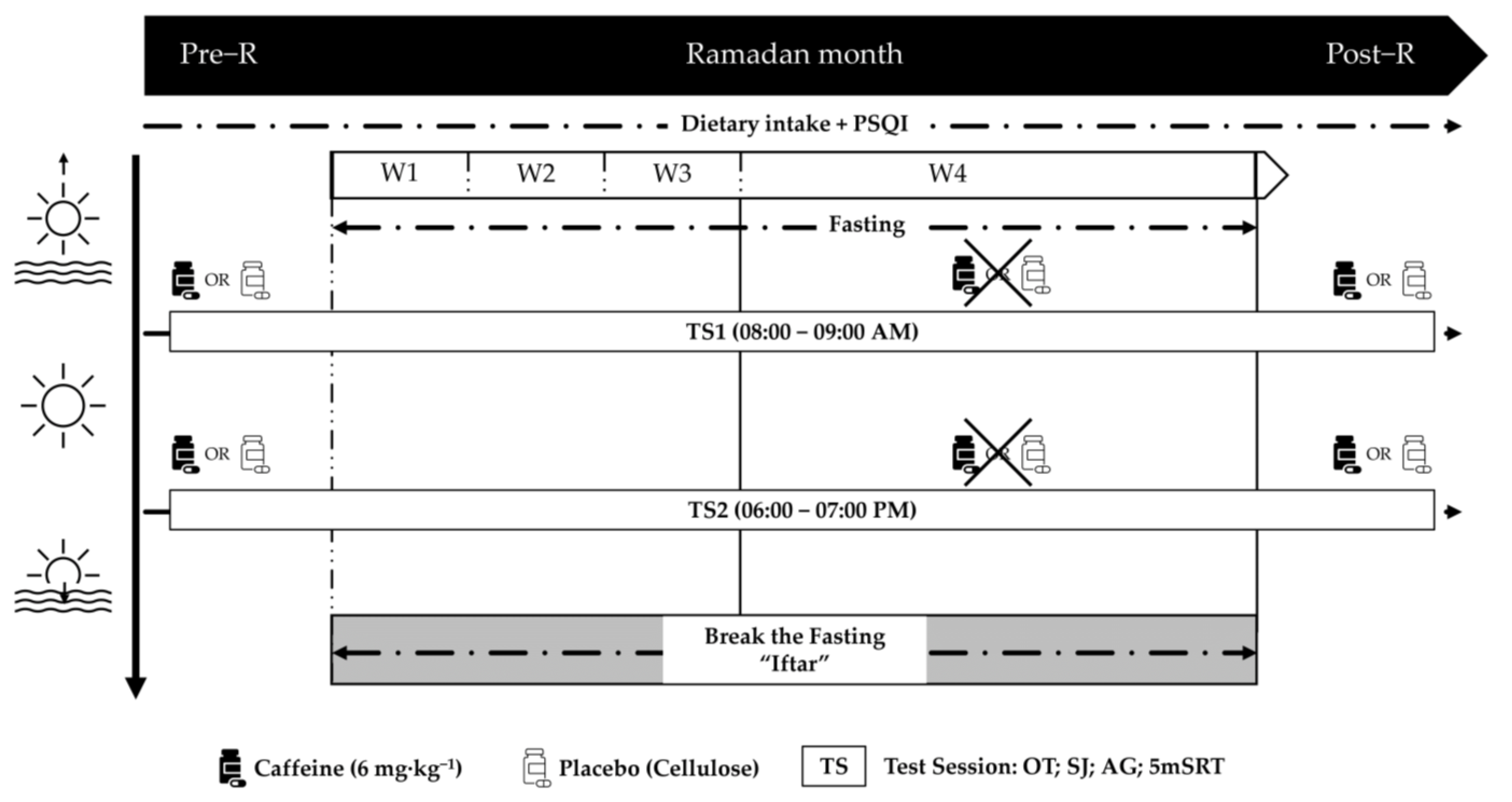
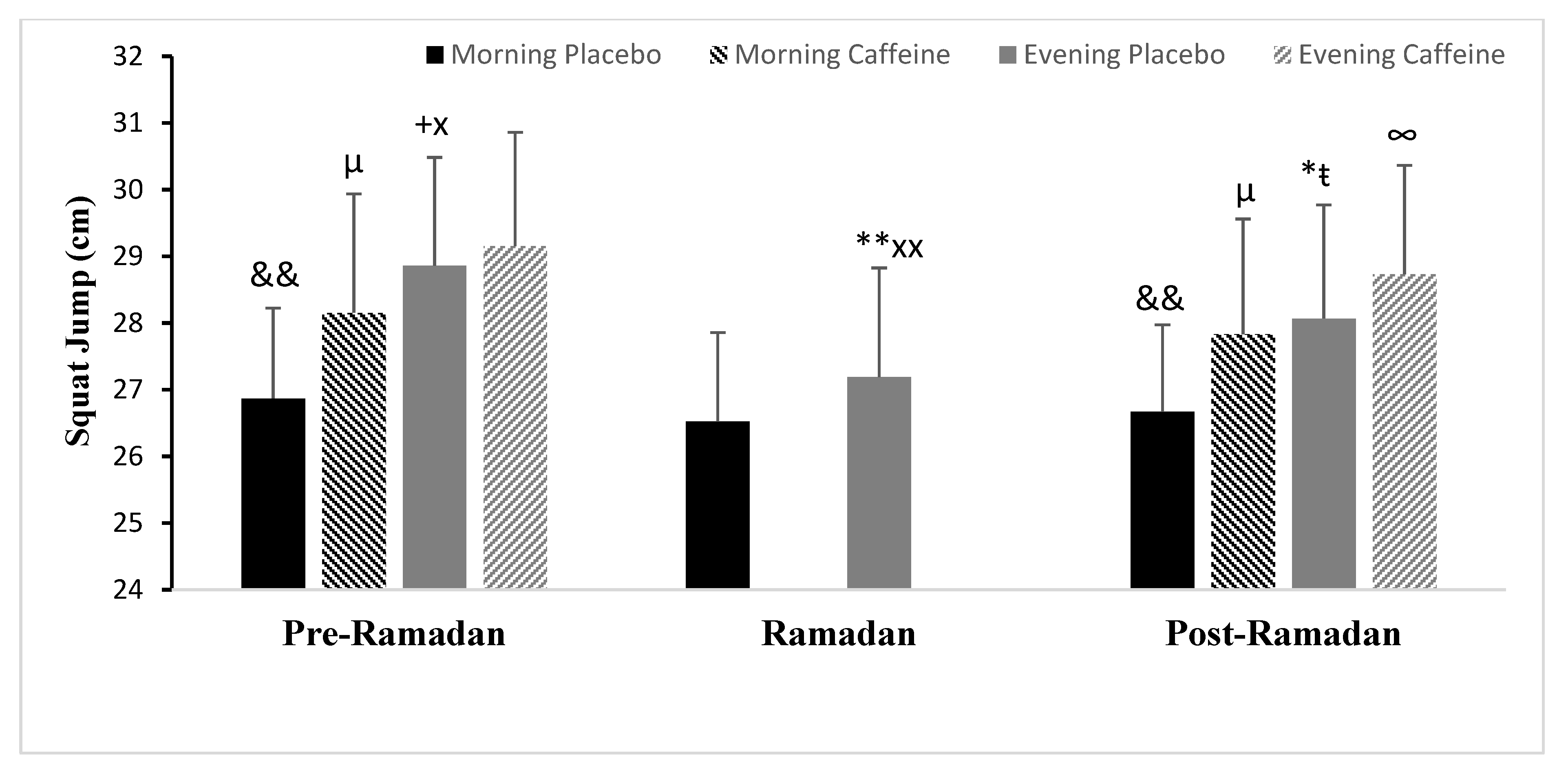
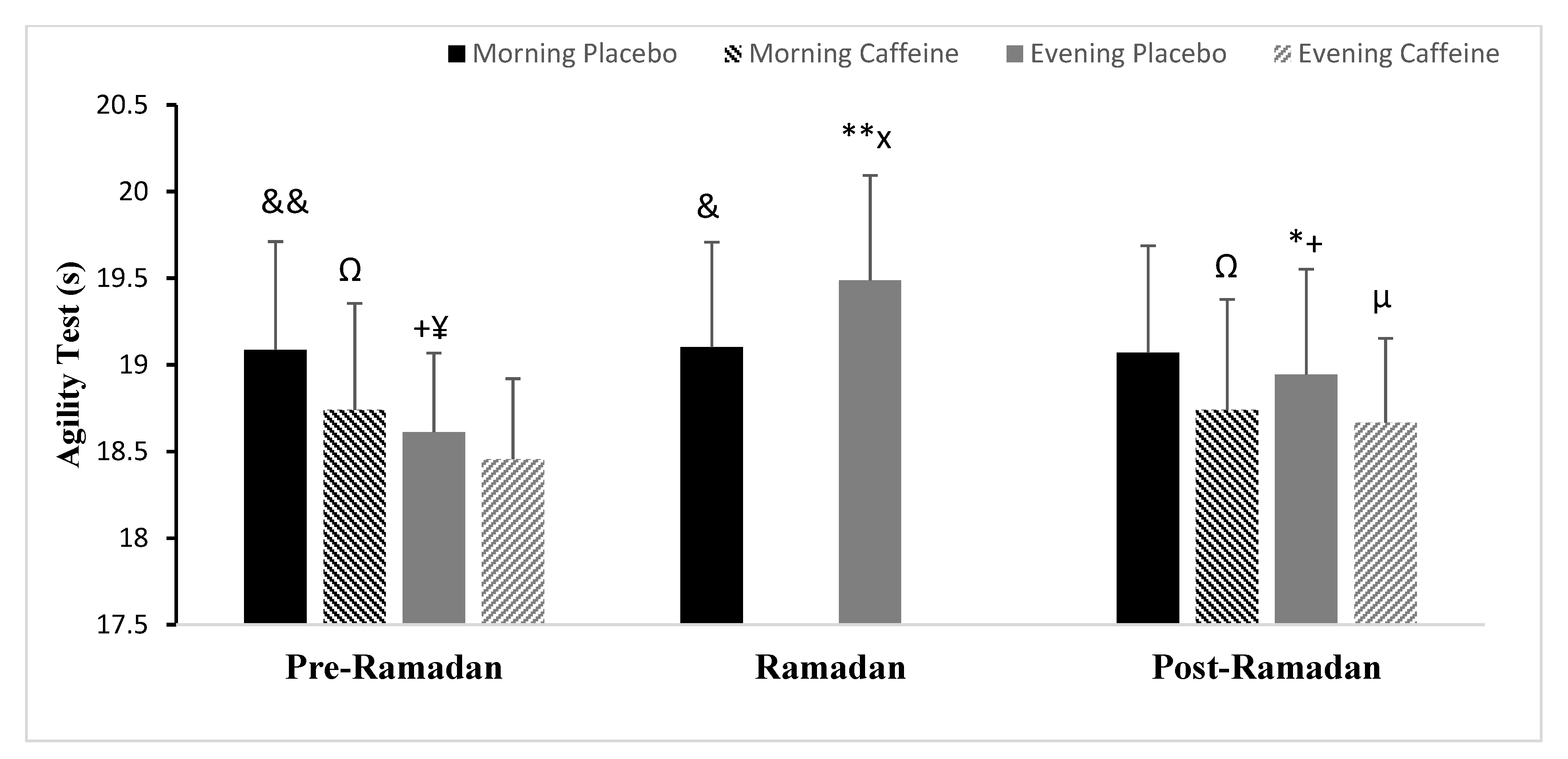
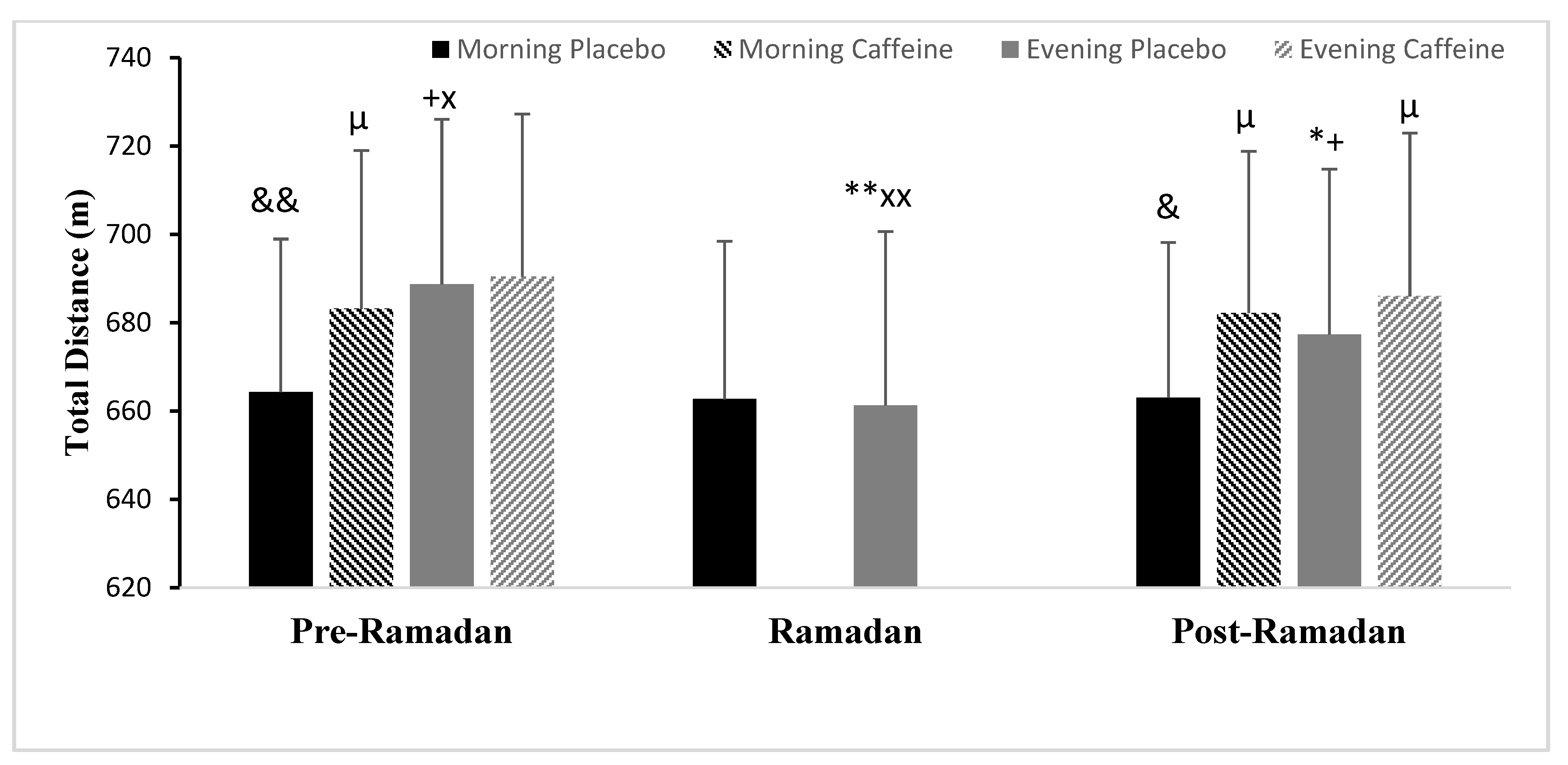
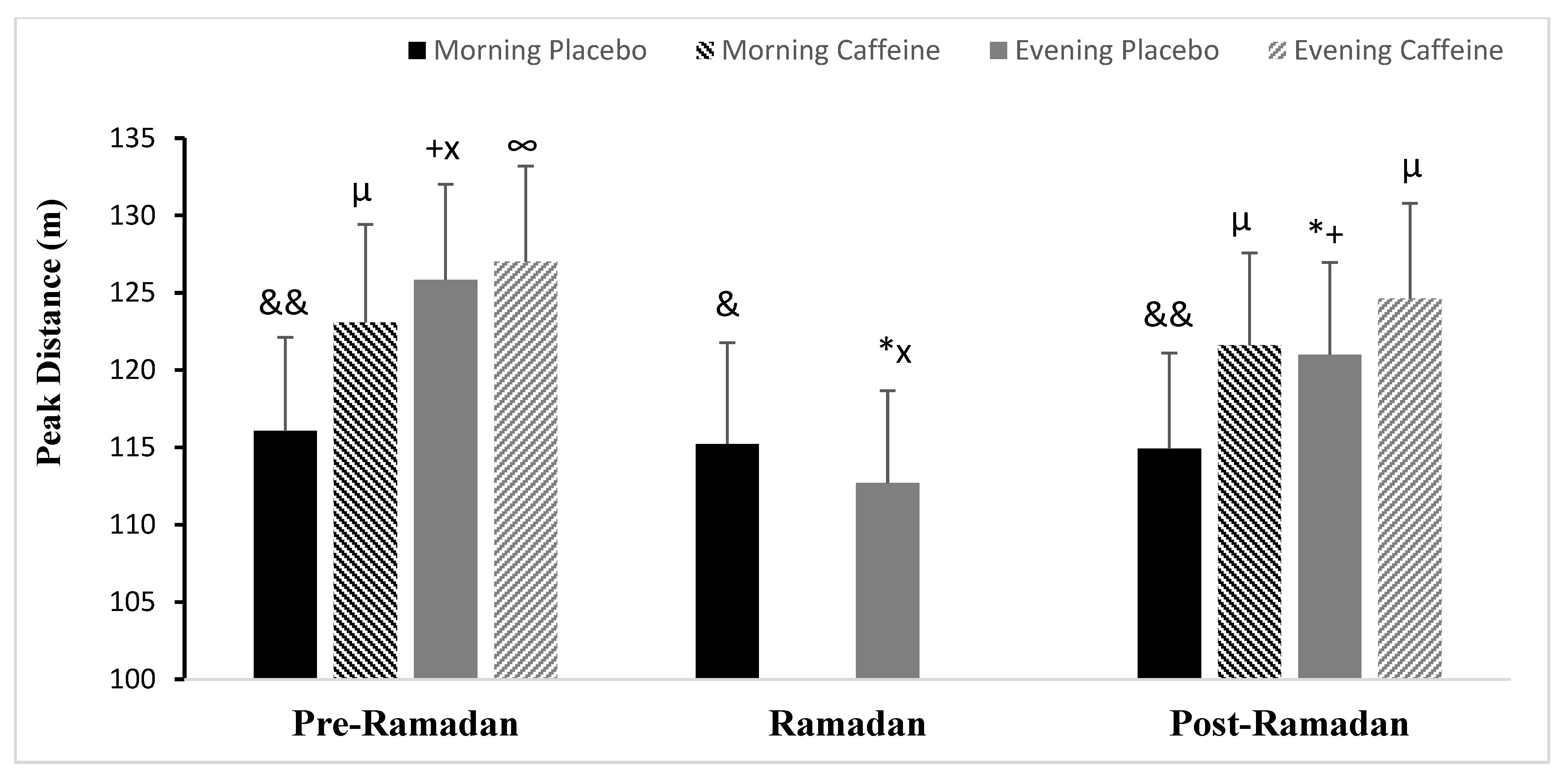
| Minimum | Maximum | Mean | |
|---|---|---|---|
| Age (years) | 16 | 17 | 16.6 ± 0.5 |
| Body mass (kg) | 51 | 76 | 59.3 ± 9.1 |
| Height (m) | 1.6 | 1.8 | 1.7 ± 0.1 |
| Body mass index (kg/m2) | 18.3 | 27.5 | 21.4 ± 2.7 |
| Daily caffeine intake (mg) | 30 | 95 | 56.2 ± 21.1 |
| MEQ questionnaire score (au) | 43 | 57 | 50.2 ± 4.6 |
| Handball experience (years) | 3 | 5 | 3.8 ± 0.6 |
| Training sessions frequency/week | 3 | 5 | 4.2 ± 0.7 |
| Usual training session duration (min) | 60 | 120 | 90 ± 22.16 |
| Pre-Ramadan | Ramadan | Post-Ramadan | p Value | |
|---|---|---|---|---|
| Protein (g/d) | 65 ± 15.7 | 62.9 ± 17.6 | 68.2 ± 16.2 | 0.31 |
| Carbohydrate (g/d) | 476.8 ± 62.5 | 480.6 ± 62.1 | 477.8 ± 61.8 | 0.26 |
| Fat (g/d) | 106.7 ± 18.8 | 107.8 ± 18.5 | 104.3 ± 19.6 | 0.12 |
| Energy intake (kcal/day) | 3282.8 ± 330.6 | 3300.4 ± 327.5 | 3277.3 ± 331.6 | 0.62 |
| Body mass (kg) | 59.3 ± 9.1 | 59.3 ± 8.6 | 59.58 ± 9.01 | 0.27 |
| Body mass index (kg/m2) | 21.4 ± 2.7 | 21.4 ± 2.5 | 21.5 ± 2.6 | 0.29 |
| Pre-Ramadan | Ramadan | Post-Ramadan | |
|---|---|---|---|
| Sleep latency (min) | 15.9 ± 1.5 | 16.2 ± 1.3 | 16.3 ± 1.3 |
| Sleep effciency (%) | 95.64 ± 4.5 +# | 90.03 ± 5.1 & | 91.67 ± 5.1 & |
| Sleep duration (h) | 7.5 ± 0.9 +# | 6 ± 0.7 &∞ | 6.5 ± 0.7 &* |
| Sleep quality (AU) | 0.5 ± 0.4 +# | 2.1 ± 0.6 &∞ | 1.6 ± 0.6 &* |
| Sleep disturbances (AU) | 0.5 ± 0.3 +# | 1.3 ± 0.4 &*Ω | 0.9± 0.2 &ŧ |
| Daytime dysfunction (AU) | 0.3 ± 0.2 +# | 0.7 ± 0.2 & | 0.9 ± 0.3 & |
| Total score of PSQI (AU) | 2.1 ± 1.2 +# | 6.4 ± 1.3 &# | 5 ± 1.2 +& |
Disclaimer/Publisher’s Note: The statements, opinions and data contained in all publications are solely those of the individual author(s) and contributor(s) and not of MDPI and/or the editor(s). MDPI and/or the editor(s) disclaim responsibility for any injury to people or property resulting from any ideas, methods, instructions or products referred to in the content. |
© 2023 by the authors. Licensee MDPI, Basel, Switzerland. This article is an open access article distributed under the terms and conditions of the Creative Commons Attribution (CC BY) license (https://creativecommons.org/licenses/by/4.0/).
Share and Cite
Bougrine, H.; Nasser, N.; Abdessalem, R.; Ammar, A.; Chtourou, H.; Souissi, N. Pre-Exercise Caffeine Intake Attenuates the Negative Effects of Ramadan Fasting on Several Aspects of High-Intensity Short-Term Maximal Performances in Adolescent Female Handball Players. Nutrients 2023, 15, 3432. https://doi.org/10.3390/nu15153432
Bougrine H, Nasser N, Abdessalem R, Ammar A, Chtourou H, Souissi N. Pre-Exercise Caffeine Intake Attenuates the Negative Effects of Ramadan Fasting on Several Aspects of High-Intensity Short-Term Maximal Performances in Adolescent Female Handball Players. Nutrients. 2023; 15(15):3432. https://doi.org/10.3390/nu15153432
Chicago/Turabian StyleBougrine, Houda, Nidhal Nasser, Raouf Abdessalem, Achraf Ammar, Hamdi Chtourou, and Nizar Souissi. 2023. "Pre-Exercise Caffeine Intake Attenuates the Negative Effects of Ramadan Fasting on Several Aspects of High-Intensity Short-Term Maximal Performances in Adolescent Female Handball Players" Nutrients 15, no. 15: 3432. https://doi.org/10.3390/nu15153432
APA StyleBougrine, H., Nasser, N., Abdessalem, R., Ammar, A., Chtourou, H., & Souissi, N. (2023). Pre-Exercise Caffeine Intake Attenuates the Negative Effects of Ramadan Fasting on Several Aspects of High-Intensity Short-Term Maximal Performances in Adolescent Female Handball Players. Nutrients, 15(15), 3432. https://doi.org/10.3390/nu15153432






